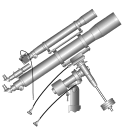Portal:Astronomie
  Portal Astronomie Willkommen auf der zentralen Anlaufstelle zum Themenbereich der Astronomie in der Wikipedia! Für Fragen und Anregungen steht die Diskussionsseite zur Verfügung. Möglichkeiten zum aktiven Mitwirken bietet die Seite Mitarbeit. Viel Spaß! | |||||||||||||||||||||||||||||||||||||||||||
(bearbeiten, Archiv) 
| (bearbeiten)  Der Meteorit Neuschwanstein erreichte am 6. April 2002 um 22:20:18 MESZ bei Füssen in Bayern in der Nähe von Schloss Neuschwanstein in deutsch-österreichischem Grenzgebiet (Ammergauer Alpen) die Erde. Der ursprüngliche Meteoroid zerbarst in einer Höhe von etwa 22 Kilometern über dem Erdboden in mehrere Fragmente, die über einem mehrere Quadratkilometer großen Gebiet niedergingen. Bisher konnten drei dieser Fragmente mit einer Gesamtmasse von rund sechs Kilogramm geborgen werden. Neuschwanstein wurde als Enstatit-Chondrit (Typ EL6) klassifiziert, eine äußerst seltene Gruppe innerhalb der Steinmeteoriten. Er gilt als der erste Meteorit in Deutschland (und als der vierte weltweit), der anhand simultaner fotografischer Aufzeichnungen aufgefunden werden konnte. | ||||||||||||||||||||||||||||||||||||||||||
(bearbeiten, alle Ereignisse) 2024
2025
| (bearbeiten, alle Bilder ansehen)  | ||||||||||||||||||||||||||||||||||||||||||
(bearbeiten, Archiv) Allgemeines: • 25.01. Kumiko Kotera • 24.01. Coulomb (Mondkrater) · Weber (Mondkrater) • 23.01. Emma Bunce · William Gascoigne • 22.01. Michail Alexandrowitsch Waschakidse · Vashakidze (Mondkrater) • 21.01. Kramers (Mondkrater) · Nikolai Petrowitsch Karatschenzow • 20.01. Samuel Tolansky • 17.01. SPHEREx • 15.01. Navarro–Frenk–White-Profil • 14.01. Bassi (Venuskrater) Individuelle astronomische Objekte: • 26.01. (7647) Etrépigny • 25.01. (7641) Cteatus • 24.01. Coulomb (Mondkrater) · Weber (Mondkrater) • 22.01. Michail Alexandrowitsch Waschakidse · Vashakidze (Mondkrater) • 21.01. Kramers (Mondkrater) • 20.01. Samuel Tolansky • 14.01. Bassi (Venuskrater) |
Einen Einstieg in die Vielfalt der Artikel aus dem Bereich Astronomie bietet sowohl der alphabetische Index als auch die hierarchische Gliederung, deren oberste Ebene hier auszugsweise erläutert wird. Die vollständige Übersicht der hierarchischen Gliederung enthält auch Hinweise zur Kategorisierung neuer Artikel. In der nachfolgenden Übersicht leiten die kursiven Links direkt zu Artikeln, die restlichen führen zu den jeweiligen Kategorien.
| ||||||||||||||||||||||||||||||||||||||||||
Commons: Astronomie – Sammlung von Bildern, Videos und Audiodateien Wikibooks: Regal Astronomie – Lern- und Lehrmaterialien Wikinews: Portal Astronomie – in den Nachrichten Wikiquote: Astronomie – Zitate Wikisource: Astronomie – Quellen und Volltexte | |||||||||||||||||||||||||||||||||||||||||||

| |||||||||||||||||||||||||||||||||||||||||||
Qualitätsprädikat: |
Auf dieser Seite verwendete Medien
Autor/Urheber: en:User:Cormullion., Lizenz: CC BY-SA 2.5
Original summary: "I drew this picture in Illustrator to illustrate the analog of the 24 hour dial".
This artist's conception shows a Jupiter-sized planet forming from a disk of dust and gas surrounding a young, massive star. The planet's gravity has cleared a gap in the disk. Of more than 500 stars examined in the W5 star-forming region, 15 show evidence of central clearing that may be due to forming planets. Image credit: David A. Aguilar, CfA
This is a mosaic image, one of the largest ever taken by NASA's Hubble Space Telescope, of the Crab Nebula, a six-light-year-wide expanding remnant of a star's supernova explosion. Japanese and Chinese astronomers recorded this violent event in 1054 CE.
The orange filaments are the tattered remains of the star and consist mostly of hydrogen. The rapidly spinning neutron star embedded in the center of the nebula is the dynamo powering the nebula's eerie interior bluish glow. The blue light comes from electrons whirling at nearly the speed of light around magnetic field lines from the neutron star. The neutron star, like a lighthouse, ejects twin beams of radiation that appear to pulse 30 times a second due to the neutron star's rotation. A neutron star is the crushed ultra-dense core of the exploded star.
The Crab Nebula derived its name from its appearance in a drawing made by Irish astronomer Lord Rosse in 1844, using a 36-inch telescope. When viewed by Hubble, as well as by large ground-based telescopes such as the European Southern Observatory's Very Large Telescope, the Crab Nebula takes on a more detailed appearance that yields clues into the spectacular demise of a star, 6,500 light-years away.
The newly composed image was assembled from 24 individual Wide Field and Planetary Camera 2 exposures taken in October 1999, January 2000, and December 2000. The colors in the image indicate the different elements that were expelled during the explosion. Blue in the filaments in the outer part of the nebula represents neutral oxygen, green is singly-ionized sulfur, and red indicates doubly-ionized oxygen.Autor/Urheber: Bayerisches Landesamt für Umwelt, Lizenz: CC BY-SA 3.0
Karten500T-Neuschwanstein
The typical atom symbol. In popular culture, it is also used as a symbol of space (see Googie architecture).
Caption from NASA: Like early explorers mapping the continents of our globe, astronomers are busy charting the spiral structure of our galaxy, the Milky Way. Using infrared images from NASA's Spitzer Space Telescope, scientists have discovered that the Milky Way's elegant spiral structure is dominated by just two arms wrapping off the ends of a central bar of stars. Previously, our galaxy was thought to possess four major arms.
This artist's concept illustrates the new view of the Milky Way, along with other findings presented at the 212th American Astronomical Society meeting in St. Louis, Mo. The galaxy's two major arms (Scutum-Centaurus and Perseus) can be seen attached to the ends of a thick central bar, while the two now-demoted minor arms (Norma and Sagittarius) are less distinct and located between the major arms. The major arms consist of the highest densities of both young and old stars; the minor arms are primarily filled with gas and pockets of star-forming activity.
The artist's concept also includes a new spiral arm, called the "Far-3 kiloparsec arm," discovered via a radio-telescope survey of gas in the Milky Way. This arm is shorter than the two major arms and lies along the bar of the galaxy.
Our sun lies near a small, partial arm called the Orion Arm, or Orion Spur, located between the Sagittarius and Perseus arms.Autor/Urheber: Peter Kemp (original) ; bayo (derivative), Lizenz: LGPL
Two books as an icon
Autor/Urheber: Bautsch, Lizenz: CC0
Die Lage des Kometen C/2023 A3 im Oktober 2024 am Sternhimmel. Der Komet steht Anfang Oktober im südlichsten Zipfel des Sternbilds Löwe (Leo) zirka zehn Bogengrad südlich der Ekliptik und zieht in der ersten Monatshälfte bei immer weiter abnehmender scheinbarer Helligkeit quer durch Sternbild Jungfrau (Virgo). Danach wechselt er in den westlichen Kopf des Sternbilds Schlange (Serpens Caput), um danach quer durch das Sternbild Schlangenträger (Ophiochus) zu ziehen. Ende des Monats erreicht der Komet eine nördliche ekliptikale Breite von gut 27 Bogengrad.
Autor/Urheber: Operarius, Lizenz: CC BY 3.0
Retouched version of de:Bild:Stonehenge, Salisbury.JPG, which has the following description: ---- Beschreibung = Stonehenge im Juli 2008 Quelle = selbst fotografiert Urheber = Operarius Datum = 24.07.2008
Autor/Urheber:
- Planeten: NASA, freigegeben
- Topografische Karte des Mars: NASA, freigegeben
- MIR im Orbit: NASA, freigegeben
- Levi Schleifenförmige Gasfilamente auf der Sonne: NASA/TRACE, freigegeben
Cover des Wikipress-Bandes Sonnensystem.
Autor/Urheber: perfectska04, GNOME icon artists, Lizenz: GPL
An icon from the GNOME-colors 5.5.1 icon theme
Autor/Urheber: Everaldo Coelho and YellowIcon;, Lizenz: LGPL
Ein Icon aus dem Crystal Clear-Thema
Autor/Urheber: Fred the Oyster, Lizenz: CC BY-SA 4.0
Equatorial-mounted Keplerian telescope.
Autor/Urheber:
- Astronomy_Amateur_3_V2.jpg: User Halfblue on en.wikipedia
- derivative work: Dirk Hünniger (talk)
Cover for the German Introductory Textbook on Astronomy.
The Cosmic Microwave Background temperature fluctuations from the 5-year Wilkinson Microwave Anisotropy Probe data seen over the full sky. The average temperature is 2.725 kelvins (degrees above absolute zero; absolute zero is equivalent to −273.15 °C or −459 °F), and the colors represent the tiny temperature fluctuations, as in a weather map. Red regions are warmer and blue regions are colder by about 0.0002 degree.
Autor/Urheber: Anne-Marie Mahfouf? Oxygen team?, Lizenz: GPL
Skalierbares High-Color-Programmsymbol im Oxygen-Stil für die Planetarium-Anwendung KStars aus der KDE Software Compilation.
Autor/Urheber: PlanetUser, Lizenz: CC BY-SA 4.0
This is a icon for Celestia reworked by FarGetaNik.
Autor/Urheber: ESO/S. Guisard (www.eso.org/~sguisard), Lizenz: CC BY 4.0
Taken by Stéphane Guisard, an ESO engineer and world-renowned astrophotographer, from Cerro Paranal, home of ESO’s Very Large Telescope, this image directly benefits from the quality of Paranal’s sky, one of the best on the planet. The image shows the region spanning the sky from the constellation of Sagittarius (the Archer) to Scorpius (the Scorpion). The very colourful Rho Ophiuchi and Antares region features prominently to the right, as well as much darker areas, such as the Pipe and Snake Nebulae. The dusty lane of our Milky Way runs obliquely through the image, dotted with remarkable bright, reddish nebulae, such as the Lagoon and the Trifid Nebulae, as well as NGC 6357 and NGC 6334. This dark lane also hosts the very center of our Galaxy, where a supermassive black hole is lurking. The image was obtained by observing with a 10-cm Takahashi FSQ106Ed f/3.6 telescope and a SBIG STL CCD camera, using a NJP160 mount. Images were collected through three different filters (B, V and R) and then stitched together. This mosaic was assembled from 52 different sky fields made from about 1200 individual images totalling 200 hours exposure time, with the final image having a size of 24 403 x 13 973 pixels. Note that the final, full resolution image is only available through Stéphane Guisard. #L
Eine wohl errechnete (simulierte – und zudem künstlerisch nachbearbeitete) Darstellung des Quasars GB 1508+5714.
Autor/Urheber: Xander, Lizenz: CC BY-SA 3.0
A modified version of calendar Tango! icon






































